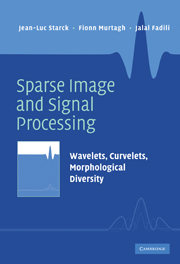Book contents
- Frontmatter
- Contents
- Acronyms
- Notation
- Preface
- 1 Introduction to the World of Sparsity
- 2 The Wavelet Transform
- 3 Redundant Wavelet Transform
- 4 Nonlinear Multiscale Transforms
- 5 The Ridgelet and Curvelet Transforms
- 6 Sparsity and Noise Removal
- 7 Linear Inverse Problems
- 8 Morphological Diversity
- 9 Sparse Blind Source Separation
- 10 Multiscale Geometric Analysis on the Sphere
- 11 Compressed Sensing
- References
- List of Algorithms
- Index
- Plate section
5 - The Ridgelet and Curvelet Transforms
Published online by Cambridge University Press: 06 July 2010
- Frontmatter
- Contents
- Acronyms
- Notation
- Preface
- 1 Introduction to the World of Sparsity
- 2 The Wavelet Transform
- 3 Redundant Wavelet Transform
- 4 Nonlinear Multiscale Transforms
- 5 The Ridgelet and Curvelet Transforms
- 6 Sparsity and Noise Removal
- 7 Linear Inverse Problems
- 8 Morphological Diversity
- 9 Sparse Blind Source Separation
- 10 Multiscale Geometric Analysis on the Sphere
- 11 Compressed Sensing
- References
- List of Algorithms
- Index
- Plate section
Summary
INTRODUCTION
The ridgelet and curvelet transforms generalize the wavelet transform. First, they incorporate angular alignment information, and then, in addition, the length of the alignment is covered. As with all of these transforms, multiple scales are supported. The motivation for these transforms is to build up an image from edge-related building blocks. Furthermore, as in previous chapters, the efficiency of computing these transforms is an important practical aspect.
In this chapter, we consider the ridgelet transform and a number of algorithms for its implementation. Then we proceed to the curvelet transform and algorithms for it.
BACKGROUND AND EXAMPLE
Wavelets rely on a dictionary of roughly isotropic elements occurring at all scales and locations. They do not describe well highly anisotropic elements and contain only a fixed number of directional elements, independent of scale. Despite the fact that they have had wide impact in image processing, they fail to efficiently represent objects with highly anisotropic elements such as lines or curvilinear structures (e.g., edges). The reason is that wavelets are nongeometrical and do not exploit the regularity of the edge curve. Following this reasoning, new constructions have been proposed such as ridgelets (Candès and Donoho 1999) and curvelets (Candès and Donoho 2001, 2002; Starck et al. 2002).
Ridgelets and curvelets are special members of the family of multiscale orientation-selective transforms, which have recently led to a flurry of research activity in the field of computational and applied harmonic analysis.
- Type
- Chapter
- Information
- Sparse Image and Signal ProcessingWavelets, Curvelets, Morphological Diversity, pp. 89 - 118Publisher: Cambridge University PressPrint publication year: 2010
- 3
- Cited by



